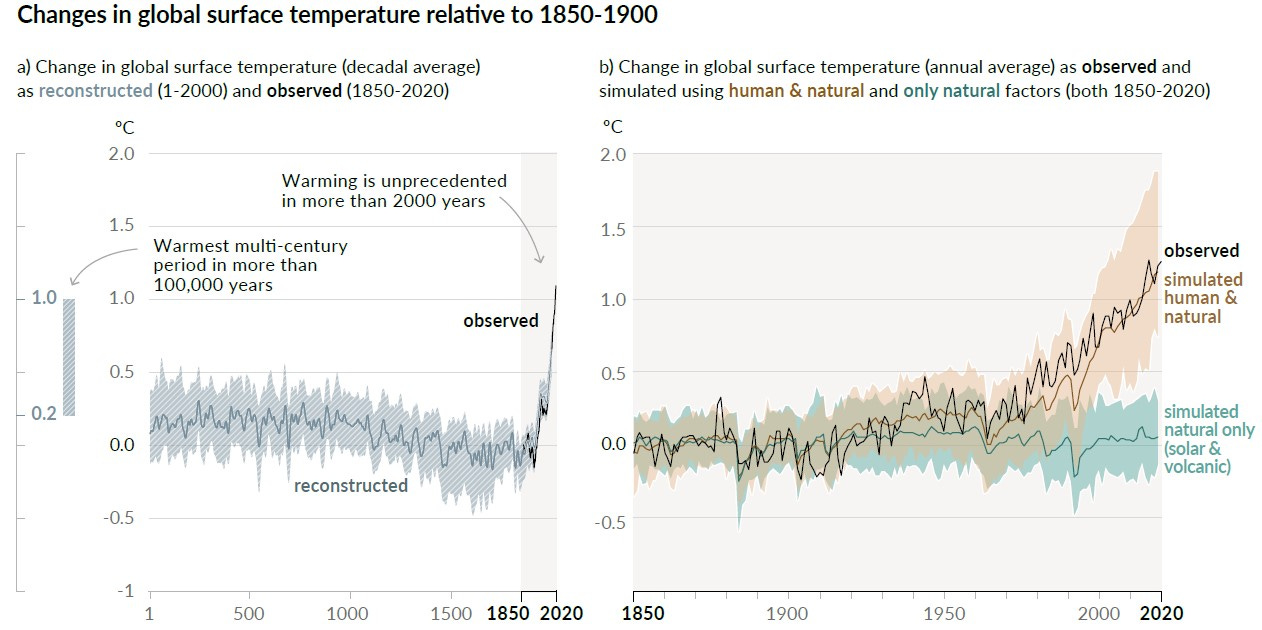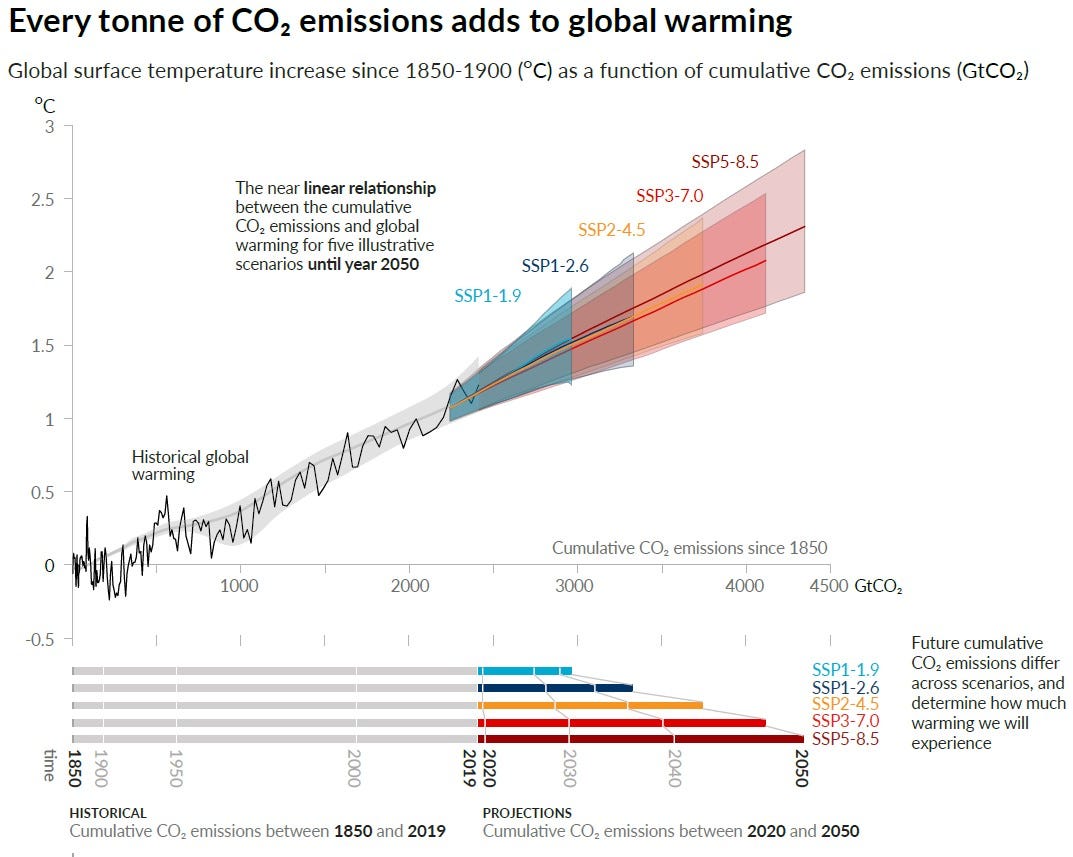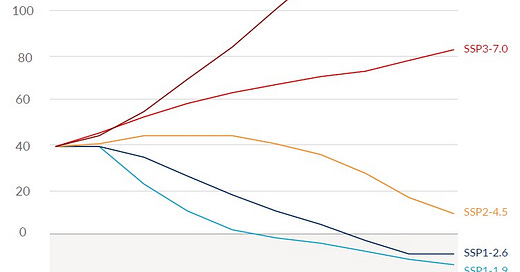Hello everyone: This week in curated Anthropocene news, I’ve got 1) an op-ed on why reducing population is no longer about avoiding ecological crisis, 2) a reality check on the ballyhooed effort by big oil companies to fund recycling plastic back into fuel, 3) a scientist’s acknowledgement of the role of grief in our response to a changing world, 4) an unsurprising article on how power companies didn’t see climate change coming, and 5) an Oxfam report reminding us that if we carelessly plant too many trees to absorb CO2 we might run out of land to grow food for people.
Now on to this week’s main story:

The big story this week is – or should be – the Sixth Assessment Report (AR6) from the U.N.’s Intergovernmental Panel on Climate Change (IPCC). To be precise, this is the report from Working Group 1, which outlines the latest understanding of the physical science behind anthropogenic climate change. (Working Group 2 will release its report in February on climate impacts, and Working Group 3 will report on the science of mitigation in March.) I’m busily taking care of loose ends while packing up for a vacation and so don’t have a real essay built around this, but I wanted to talk a bit about the report, some reporting on it, and what kind of world the report has landed in.
U.N. Secretary-General António Guterres (and his media staff, I assume) found a catchy, click-bait phrase to describe the AR6: “A code red for humanity.” This was clever. Type “code red” into a Google search bar and his phrase tops the list of options; hit Enter and watch a very long line of media articles using the phrase scroll by. My hope is, by way of providing some context for the Code Red, the articles quote the rest of Guterres’ opening salvo: “The alarm bells are deafening, and the evidence is irrefutable: greenhouse‑gas emissions from fossil-fuel burning and deforestation are choking our planet and putting billions of people at immediate risk. Global heating is affecting every region on Earth, with many of the changes becoming irreversible.”
The strength and weakness of the U.N. is that it does not represent any particular nation or set of business interests (to what extent it has been influenced by these is a question for another writer), and so it can make science-based statements that will infuriate some governments that are beholden to industry, as when Guterres writes this sensible and necessary analysis:
This report must sound a death knell for coal and fossil fuels, before they destroy our planet. There must be no new coal plants built after 2021. OECD [Organisation for Economic Co-operation and Development] countries must phase out existing coal by 2030, with all others following suit by 2040. Countries should also end all new fossil fuel exploration and production, and shift fossil-fuel subsidies into renewable energy. By 2030, solar and wind capacity should quadruple and renewable energy investments should triple to maintain a net-zero trajectory by mid-century.
But the Secretary-General is not the force behind the AR6. The force behind it is a slow, cautious, unstoppable army of scientists doing the research, reviewing the research, arguing over the quality and meaning of the research, and writing and editing and commenting on the report. The report has 234 authors from 66 countries, with an additional 517 contributing authors. It cites over 14,000 references and reflects in its final form the input from over 78,000 comments made by experts and government officials.
The full report is 1300 pages long. I confess I have merely peeked at it, like a child confronted with the full-sized Oxford English Dictionary. There are two-scaled-down versions: a Technical Summary of 150 pages and a Summary for Policymakers of 39 pages. I’m more interested in policy than in technical details or earning a PhD in climate science - and I’m about to go on vacation - so I opted for the latter. And even that summary is not really policymaker-friendly for the average policymaker, in my opinion, or at least not for the policymaker who got into office to improve their resume or golf score. It is concise and profound, but it is still at times a difficult read. Much of this is due to the technical language rather than the basic content. The first paragraph below is about the oceans continuing to warm and transform for centuries to come, and the second is about the direct correlation between our CO2 emissions and the rise in planetary temperatures:
B.5.1 Past GHG [greenhouse gas] emissions since 1750 have committed the global ocean to future warming (high confidence). Over the rest of the 21st century, likely ocean warming ranges from 2–4 (SSP1-2.6) to 4–8 times (SSP5-8.5) the 1971–2018 change. Based on multiple lines of evidence, upper ocean stratification (virtually certain), ocean acidification (virtually certain) and ocean deoxygenation (high confidence) will continue to increase in the 21st century, at rates dependent on future emissions. Changes are irreversible on centennial to millennial time scales in global ocean temperature (very high confidence), deep ocean acidification (very high confidence) and deoxygenation (medium confidence).
D.1.1 This Report reaffirms with high confidence the AR5 finding that there is a near-linear relationship between cumulative anthropogenic CO2 emissions and the global warming they cause. Each 1000 GtCO2 of cumulative CO2 emissions is assessed to likely cause a 0.27°C to 0.63°C increase in global surface temperature with a best estimate of 0.45°C. This is a narrower range compared to AR5 and SR1.5. This quantity is referred to as the transient climate response to cumulative CO2 emissions (TCRE). This relationship implies that reaching net zero anthropogenic CO2 emissions is a requirement to stabilize human-induced global temperature increase at any level, but that limiting global temperature increase to a specific level would imply limiting cumulative CO2 emissions to within a carbon budget.
If you made it through those two paragraphs you’ll have noticed, among other things, the constant parenthetical references to confidence level. They read to me like actor’s notes in a script – “be more assertive re: acidification than deoxygenation!” – but these are in fact the signature of the climate science community’s honest assessment of the strength of the data. This Working Group 1 report is an astonishingly large effort to describe the climate-addled world we’re making, and it is also an astonishingly honest effort.
That said, the palpable desire for transparency – Here are the citations! Here is the range of possibilities! Here is how confident we are in the analysis! – makes me wonder how much of the painstaking effort is due simply to scientists being thorough because their report is the foundation upon which civilization decides whether to fix itself, and how much is due to the political maelstrom awaiting the report. (The politics of the past thirty years for the IPCC and climate science in general has been extraordinarily difficult at times, often for the scientists themselves. In 1995, when the IPCC’s AR2 merely concluded that humans were having a “discernible” impact on climate, the attacks began in earnest.) The fact that I have to wonder how much the IPCC shapes their writing because they expect attacks and disinformation funded by fossil-fuel companies is disturbing, given that we have far more important and difficult things to do than deal with half-witted skeptics, political hacks, and corporate cynics. When the report unnecessarily notes, for example, that in charting several future CO2-emission scenarios, “these projections account for solar activity and background forcing from volcanoes,” I have to assume that the authors and their colleagues are tired of hearing from Facebook-educated trolls who think scientists don’t know that volcanoes emit CO2 too.
But it is also true that in the AR6 the IPCC has shaken off much of its political caution. It is, as the Economist says, a “broadside” compared to the tentative statements of earlier decades. The Economist summarizes the broadside this way:
Human influence on the climate is now “unequivocal”: it is why the world is 1.1ºC (2ºF) hotter than it was in the late 19th century; it has moved jet streams, shrunk glaciers, stripped away Arctic sea ice, contributed to two decades of increased melting of the Greenland ice sheet, warmed the oceans and driven the past 50 years of sea-level rise… Much of the reason for this confidence is, unfortunately, experience. Again and again the report brings home that the reason why science can say so much more about climate change and its likely course now is that it has seen it actually going on…

This brings me finally to the report itself. The Summary for Policymakers has four sections: A) The Current State of the Climate, B) Possible Climate Futures, C) Climate Information for Risk Assessment and Regional Adaptation, and D) Limiting Future Climate Change. The first section works from improved and increased data, from old and new lines of evidence, to make it brutally clear what’s happening and why. The opening salvo is straightforward: “It is unequivocal that human influence has warmed the atmosphere, ocean and land. Widespread and rapid changes in the atmosphere, ocean, cryosphere and biosphere have occurred.”
The second section creates five illustrative future scenarios, ranging from a very optimistic depiction of a limited climate crisis due to quick and massive efforts… to a deeply disturbing scenario in which runaway emissions leads to runaway heating and ecological collapse. The third and fourth sections are pretty much described by the titles: outlines of the latest climate science as pertains to assessing, adapting to, and reducing the impacts of our greenhouse gas emissions. A third of the entire report is devoted to providing regional data on climate change so that those regions can plan for the changes that will continue to worsen. This focus on adaptation signifies, again, that the AR6 is done with portraying climate change as hypothetical. The crisis has begun.
A short, punchy NPR explainer provided three takeaways from the AR6: 1) “Humans are causing rapid and widespread warming;” 2) “Extreme weather is on the rise and will keep getting worse;” 3) “If humans cut emissions, the worst impacts are avoidable.”
The New York Times, always the overachiever, provided five takeaways: 1) “Human influence has unequivocally warmed the planet;” 2) “Climate science is getting better and more precise;” 3) “We are locked into 30 years of worsening climate impacts no matter what the world does;” 4) “Climate changes are happening rapidly;” 5) “There is still a window in which humans can alter the climate path.”
The chattier, in-your-face journalists at Mother Jones asked, "When was the last time we saw heating this fast? At least 2,000 years ago and probably 100,000 years. Temperatures this high? At least 6,500 years. Sea level rising so fast? At least 3,000 years. Oceans so acidic? Two million years."
And those numbers are most likely quite conservative. The IPCC never puts out anything speculative or exaggerated. Moreover, what we’re seeing now is just the beginning of the impacts associated with the 1.2C warming we’ve already created. We’re on a slide careening down into the furnace. By the time we start feeling the new normal for the current heating we’ll already be feeling the edges of the increased warming we’ve committed to.
And as the report notes, “Many changes due to past and future greenhouse gas emissions are irreversible for centuries to millennia,” even if we buckle down and curb emissions over the next several years. We’ve crossed thresholds that cannot be uncrossed, and we may have crossed some tipping points. No matter how quick we respond, ice on Earth is largely going away, other than in Antarctica, and the oceans are becoming warm, acidic, stratified, deoxygenated mysteries. (Weirdly, the report talks much more about sea-level rise than acidification, even though the latter will impact humanity far harder and far sooner.) How much ice loss and ocean upheaval happens is up to us. The entire thrust of this IPCC report is to create a scientific rationale for immediate action to limit the future number of those thresholds and tipping points.

The best course of action is to full-stop humanity’s fossil-fuel infrastructure in as short a timeline as possible, as the Secretary-General noted. We’ve burned through enough fossil fuels to emit 2400 billion tons of CO2 since 1850, and if we want a good chance of hitting the optimistic outcome projected by the IPCC – keeping global heating to 1.5C – we can only emit another 400 billion tons. Currently we emit about 40 billion per year.
But if we somehow manage that, then we could see the far side of certain aspects of this crisis. We’ll settle into the new normal of 1.5C as we try to reduce atmospheric CO2 further, and as we figure out how to cope with the moderate increase in heat waves, droughts, wildfires, flooding, storms, ecosystem shifts, farmland desertification, extinctions, and ocean upheaval, but at least we’ll have staunched the bleeding.
If we think of the Code Red for humanity as a medical emergency, we haven’t even wheeled the patient into the ER yet. We’re on the side of the highway looking at the accident – or at least the IPCC is looking – and thinking about how to extricate the patient from the source of their critical injuries. Curbing the Earth’s heating to 1.5C – again, this is the most optimistic scenario the IPCC could rationally imagine – will be no less and no more than stabilizing the patient.
And yet this is looking like an extraordinary amount of optimism. The middle of the road emissions scenario suggests that it’s quite likely we’ll increase global temperature by 2.5C by midcentury, and that’s a climate the planet hasn’t seen for over three million years, when sea levels were about 80 feet higher. Plus, the report notes (in section B.4.3) that emissions of CO2 and methane from wetlands, permafrost thaw, and wildfires are still not fully included in the climate models. Those could be massive sources of emissions, particularly methane, and particularly because there’s a likely feedback loop in which Arctic warming increases forest fires and peat fires and permafrost thawing, which increases Arctic warming…
The Code Red is competing in the 24 hour news cycle with breathless updates on Covid-19 outbreaks, the New York governor’s resignation, celebrity gossip, and of course the updates on horrific fires in California, Canada, and Greece. I’d like to think the heft and intelligence of the AR6 is providing context for all of this, but we’ll see which of these headlines is still in the news next week, and the week after.
It doesn’t help, I think, that the AR6 authors are not communicating to the general public. They rely entirely on media and governments and NGOs to translate their technical depiction of the Earth’s traumatic changes to us, and to take action based on the impeccable quality and importance of the science.
But maybe it’s best that the scientists are firewalled from the daily news cycle. They’ve done their job and are very intently asking governments and businesses to do their jobs based on the information provided. The IPCC has laid out the physical reality of the climate crisis in this WG1 report, and in the months and years to come will lay out with increasing clarity the story of our impacts and the possibilities of mitigation.
Science is acting as advisor to civilization, informing, providing options, even cajoling as the crisis intensifies. But civilization has to make the decisions.
That’s us, plus the people we hire to represent us.
Finally, I just want to note that despite its heft and density, the IPCC AR6 WG1 report is, in its way, beautiful. It is monumental, though just part of the greater monument built by the IPCC since its origin in 1988. It’s a monument to science, to the search for truth in a time of crisis, and to the thousands upon thousands of people who have dedicated their lives to understanding our role, and our responsibility, in this planetary moment.
Links:
Summary for Policymakers of the AR6 WG1 report from the IPCC: https://www.ipcc.ch/report/ar6/wg1/downloads/report/IPCC_AR6_WGI_SPM.pdf
U.N. Secretary-General’s statement on the AR6: https://www.un.org/press/en/2021/sgsm20847.doc.htm
Economist Climate Issue newsletter: https://view.e.economist.com/?qs=73c4250eb9e7e8dedd61474b62a74f874194d43e960c465a3d3d852184af9c77d29e6e11350c0ba13932f511d0a1a24fdd7e25453b89229fb0ca05d046f43bec8e5a4c0119c2c793e6b197ce1cf4a5f6
NPR quick explainer article on their three takeaways from the report: https://www.npr.org/2021/08/10/1026137992/3-things-to-know-about-what-scientists-say-about-our-future-climate
NYT summary with five takeaways: https://www.nytimes.com/2021/08/09/climate/un-climate-report-takeaways.html
Mother Jones summary: https://www.motherjones.com/environment/2021/08/unequivocal-ipcc-report-human-climate-change-fires-floods-heatwaves-climate-emergency/
In Other Earth-Shattering News:
“The most ethical gift we can give the people and creatures of the late 21st century and early 22nd century is a chance.” An intense op-ed in Ecological Citizen from Joe Bish of the Population Media Center makes it clear that conversations about reducing population (through voluntary family planning) is no longer about avoiding ecological crisis. “That ship has sailed,” he says: https://www.ecologicalcitizen.net/article.php?t=most-ethical-gift-towards-sustainable-demographic-future
Plastic isn’t really being recycled back into fuel, despite the claims of big oil companies who are funding the effort. Here’s some investigative journalism from Reuters: https://www.reuters.com/investigates/special-report/environment-plastic-oil-recycling/
How do we rationally and emotionally respond to the radical, frightening changes being wrought by climate change? One scientist, author of Under the Sky We Make: How to Be Human in a Warming World, says we need to be honest with our grief at the same time we’re determined to limit the damage: https://www.sciencemag.org/news/2021/04/sink-your-grief-how-one-scientist-confronts-emotional-toll-climate-change
Power companies, like the rest of us, did not see climate change coming as quickly as it has: https://www.nytimes.com/2021/07/29/climate/electric-utilities-climate-change.html
One of the many problems with trying to reduce CO2 by massive tree-planting programs, according to a new Oxfam report, is that it’s likely to drive up food prices by taking up agriculture land: https://www.motherjones.com/environment/2021/08/oxfam-study-planting-trees-carbon-offsets-climate-change-food-insecurity



